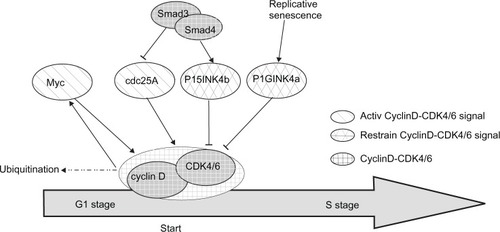 ?Mathematical formulae have been encoded as MathML and are displayed in this HTML version using MathJax in order to improve their display. Uncheck the box to turn MathJax off. This feature requires Javascript. Click on a formula to zoom.
?Mathematical formulae have been encoded as MathML and are displayed in this HTML version using MathJax in order to improve their display. Uncheck the box to turn MathJax off. This feature requires Javascript. Click on a formula to zoom.Abstract
Background
This study investigated the dual control mechanism of the Shuanghuang Shengbai granule in modulating the cell cycle in Lewis-bearing mice with cyclophosphamide induced myelosuppression.
Methods
Thirty Lewis-bearing mice were randomly grouped into an untreated group, control group, and treated group. Both treated and untreated groups were intraperitoneally injected with cyclophosphamide to produce a myelosuppression model. Mice in the treated group were fed with the Shuanghuang Shengbai granule (40 g/day) for 6 consecutive days. Standard blood tests and the count of bone marrow nuclear cells were performed, and the cell reproductive cycles of bone marrow and tumors were measured in these mice. In addition, the western blot approach was used to measure the upstream activating signals of CyclinD-CDK4/6 such as c-Myc and CDC25A, the upstream suppression signals such as p16INK4a, and the expression of downstream activated signals such as Rb, pRB, and E2F. All of the tested results were validated by reverse transcription quantitative real-time polymerase chain reaction.
Results
The results showed that the Shuanghuang Shengbai granule could elevate the count of leukocyte and bone marrow nuclear cells of Lewis-bearing mice with cyclophosphamide induced myelosuppression. It could also stimulate bone marrow cells to move from G0/G1 phases to S phase, accelerating the progress of the cell reproductive cycle and increasing the cell proliferation index. Simultaneously, the Shuanghuang Shengbai granule could also suppress cancer cells moving from G0/G1 phase to S phase, reducing the proliferation index. The tumor weight of Lewis-bearing mice in the treated group was much less than those of the control group. Expression levels of c-Myc, CDC25A, Rb, pRb, and E2F of bone marrow in Shuanghuang Shengbai granule-treated mice was higher compared to the control group, whereas they were lower in the cancer cells.
Conclusion
The experimental results demonstrate that the Shuanghuang Shengbai granule has dual control on the cell reproductive cycles in cancer cells and bone marrow nuclear cells in Lewis-bearing mice.
Introduction
Chemotherapy is one of the primary approaches for cancer treatment. Chemotherapy destroys cancer cells anywhere in the body, and they kill cells that are extremely active. Cancer cells are extremely active. However, the fast-dividing cells of the body, such as blood cells and the cells lining the mouth, stomach, hair, and intestines, also account for chemotherapy’s destructive side effects.Citation1 The destruction of normal cells, especially the hematopoietic stem cells, deteriorate the human immune system and significantly suppresses bone marrow function, leading to leucopenia.Citation1
During the chemotherapy-induced myelosuppression period, the proliferation of bone marrow cells will help patients recover, and in contrast the proliferation of cancer cells will accelerate cancer growth and aggravate the sickness. Currently, the main drug for chemotherapy-induced myelosuppression is the recombinant human granulocyte colony-stimulating factor injection (rhG-CSF). The rhG-CSF can effectively prevent chemotherapy-induced neutropenia, and enhances the function of mature neutrophils, which is vital for the human body’s reactive defense system.Citation1
However, recent studies have shown that rhG-CSF also accelerates the growth of cancer cells along with the stimulation of bone marrow to generate blood cells.Citation2,Citation3 Therefore, many clinicians have now raised concern about the safety of rhG-CSF injection. It has become important to develop a new drug that can promote the proliferation of hematopoietic stem cells, while simultaneously suppressing the proliferation of cancer cells. Herbal medicine has been shown to restore chemotherapy or irradiation-induced myelosuppression through the stimulation of granulocyte colony-stimulating factor (G-CSF) secretion. Lycium barbarum polysaccharide was shown to promote the peripheral blood recovery of irradiation or chemotherapy-induced myelosuppressive mice, and the effect was attributed to the result of the stimulation of peripheral blood mononuclear cells to produce G-CSF.Citation4 In addition, Guo et alCitation5 showed that the promotion of Epo and G-CSF gene expressions in bone marrow could potentially be one of the mechanisms underlying the blood enriching function of the Chinese herb, Siwu Tang.
The cell reproductive cycle is a chronological process that starts from the end of a cell’s last mitosis to the end of a cell’s current mitosis. A standard cell reproductive cycle is composed of four consecutive phases: the G1 phase (Gap 1 phase), S phase (deoxyribonucleic acid (DNA) synthesis phase); G2 phase (Gap 2 phase); and M phase (mitosis phase). G1 phase, S phase, and G2 phase together are also defined as interphase. By going through the interphase and mitosis phase, a parental cell can complete the whole proliferation process, generating two offspring cells with the same genetic material.Citation6–Citation8
The key controlling point of the cell reproductive cycle where proliferation starts is between the G1 and S phases. The controlling point in mammalian cells is called the “restriction point,” which decides whether the cells can go through the G1 phase to the S phase, so as to start the cell reproductive cycle.Citation9 Sub-G1 phase DNA content is suggestive of apoptosis, which is generally detected by flow cytometry analysis. Chemotherapeutic agents like suberoylanilide hydroxamic acid has been shown to significantly inhibit cell cycle progression (sub-G1 arrest) and to induce apoptosis in colon cancer cells.Citation10 The whole control process is strictly regulated by internal/external signals of the cells. Cell reproduction signals, such as growth factors, initiate the transaction of multiple genes by variable signal transaction approaches, driving cells to start the reproductive cycle.
The classical approach to relate the signals and the cell restriction point is the signal pathway whose core is CyclinD-CDK4/6. When growth signal and early response gene signal reaches the restriction point, the CyclinD expression increases, and then CyclinD and CDK 4/6 together form a complex of CyclinD-CDK 4/6, which has an activated protein kinase, driving the cell cycle to start. In this whole process, upstream signal c-Myc and CDC25A activate the CyclinD-CDK4/6, whereas p16INK4a and p15INKb suppress CyclinD-CDK 4/6. The integration and separation of downstream signal Rb and E2F relies on the activated status of CyclinD-CDK4/6. Therefore, all the molecules on the signal chain act on each other mutually to decide if the cell reproductive cycle can pass the G1 phase and move to next phase ().
Professor Zhen-ye Xu from Longhua Hospital, which is affiliated with Shanghai University of Traditional Chinese Medicine, developed the Shuanghuang Shengbai granule by leveraging the yin-yang balance to treat cancer. The new granule has been applied in clinical treatment and has been achieving the objectives in cancer patients. From preclinical trials,Citation11–Citation13 it has been established that the Shuanghuang Shengbai granule can diminish chemotherapy-induced myelosuppression and help in the recovery of normal leukocyte count. The clinical effectiveness has proved to be reliable and durable. The Shuanghuang Shengbai granule can stimulate the proliferation of bone marrow cells and it can act positively on the expression of CyclinD-CDK4/6 in the bone marrow.
This study was developed based on the results of previous research, and from the approach of controlling the CyclinD-CDK4/6 signal pathway. We have previously shown that the expressions of CDK4, CDK6, and Cyclin D1 in bone marrow and tumor tissues in the untreated group were higher when compared to the control group.Citation13 Compared to the untreated group and the control group, the expressions of CDK4, CDK6, and Cyclin D1 were higher in the bone marrow of the treated group; however, the expressions of CDK4, CDK6, and Cyclin D1 in tumor tissues were lower when compared to the untreated and control groups.Citation14 The current study aimed to further investigate the impact of the Shuanghuang Shengbai granule on extenuating chemotherapy-induced myelosuppression, and to argue the nature of Chinese medicine theory to treat bone marrow suppression by enhancing kidney function.
Materials and methods
Experimental drug
The Shuanghuang Shengbai granule consists of Astragalus, Polygonatum, Drynaria, Ligustrum lucidum, Radices trichosanthis, and Herba epimedii. The drug was manufactured by Shanglian Pharmaceutical Company (Shanghai Shanglian Pharmaceutical Co, Ltd, Shanghai, People’s Republic of China; after being authorized by Professor Xu Zhen-ye) with a unit weight of 15 g/bag. Cyclophosphamide (CTX) injection was supplied by Jiangsu Hengrui Medicine Company (Jiangsu Hengrui Medicine Co, Ltd, Jiangsu, People’s Republic of China). The drug dosage was based on the previous research on the Shuanghuang Shen baigranule.Citation11–Citation13
Reagents and antibodies
Goat antimouse secondary antibody (c-Myc), goat antirabbit secondary antibody N-myc, L-myc, p16INK4a, Rb, E2F, and rabbit antigoat secondary antibody (CDC25A, p15INK4b, and p-Rb) were purchased from Sigma Chemicals (Sigma Chemicals, Perth, Australia).
Animal model and experimental groups
The setup of the previous experiment used 30 specific pathogen free C57BL/6J inbred male mice, weighing 18~21 g each, license number 2009–0003.Citation15 All the mice were purchased from the Shanghai Experimental Animal Co, Ltd (Shanghai, People’s Republic of China), and they were raised in the specific pathogen free-class breeding room in the Shanghai University of Traditional Chinese Medicine. The Lewis lung cancer mice were donated from the Shanghai Chest Hospital (Shanghai, People’s Republic of China).
Lewis carcinoma of lung oncocyte of mice cancer cells were used for inoculation. These were solid tumor cells with tumor growth characteristics. According to the standard experimental process, after 14 days of passaging, the Lewis lung cancer mice were killed by breaking their necks and they were disinfected by 75% alcohol. The tumor was peeled off under sterile conditions. The mice were operated on ice, the necrotic part was removed, and the tumor tissue was cut into little pieces by disinfected scissors. A total of 4 mL of saline was added into a burnisher, and the tumor tissue was ground and filtered. The number of cells was counted by the cell counting chamber under microscope; the tumor cells were adjusted to 1 × 107 cells/L, inoculated into the left armpit of C57BL/6 J mice by a 1 mL syringe, at a dose of 0.2 mL per mouse.
When the tumor in the mouse became palpable, mice with similar tumor sizes were selected and randomly segmented into either an untreated group, a control group, or a treated group with ten mice in each group. Each group, kept in separate cages, was medicated separately, and drug dose was decided as per previous research and methods.Citation16
The control group and treated groups were injected with intraperitoneal CTX (2 mL per mouse). These two groups represented the myelosuppression model. The untreated group was intraperitoneally injected with normal saline (2 mL per mouse, once a day for 3 consecutive days). Mice in the treated group were fed with the Shuanghuang Shengbai granule (0.4 mL/day which equals to 40 g of the raw drug) immediately after intraperitoneal injection. For evaluation, mice in the untreated group and control group were fed with normal saline (0.4 mL/day, once a day for 6 consecutive days). After administration of the medication, blood samples were collected through the tail vein of the mice on days 1, 4, and 6 from all three groups. On the last day, and 2 hours after feeding, the eyeball of every mouse in all three groups was taken to collect blood samples, and all the mice were killed by breaking their necks. After killing, the bilateral femur and tibia of each mouse was quickly collected under sterile conditions for further study.
The bone marrow suppression model of Lewis-bearing mice is as follows: Lewis-bearing mice similar in weight and tumor size were selected after 14 days of tumor passaging, and they were intraperitoneally injected with 0.01 g/L of CTX, or 0.2 mL/day, which was equal to 100 mg/kg/day The mice were injected for 3 consecutive days to prepare the model.
Leukocyte and bone marrow nucleated cel counting
The leukocyte and bone marrow nuclear cell (BMNC) counts were done by the automatic blood cell analyzer and microscopic cell counting plate, respectively.
Measurement of cell reproductive cycle progress and the cell proliferation index (PI)
Tumor and bone marrow was collected and made into a single cell suspension separately, then the cell number was adjusted to 1 × 106/L fixed by 95% ethanol. Propidium iodide staining was used to dye the cells. The process of the cell reproductive cycle was monitored by flow cytometry cases, and the recorded data was used to calculate the proportion of cells at G0/G1 phase and PI. PI was calculated using the formula:
Total ribonucleic acid was isolated from the cells by acid guanidiniumthiocyanate–phenol–chloroform extraction. Reverse transcription was carried out on 1 μg of total ribonucleic acid for 1 hour at 42°C using oligo-dT primers and Moloney Murine Leukemia Virus reverse transcriptase, according to the vendor’s instruction (Shanghai Biotech Company, Shanghai, People’s Republic of China). Polymerase chain reaction (PCR) with Taq DNA polymerase was performed for 29 cycles for c-Myc, 30 cycles for CDC25A, 28 cycles for p16INK4a, 29 cycles for Rb, 31 cycles for pRb, and 28 cycles for E2F using the following protocol: 95°C for 60 seconds, 95°C for 10 seconds, and 60°C for 30 seconds. The PCRs were carried out using primers for c-Myc (sense primer: 5′-TCTCCATCCTATGTTGCGGTC-3′; antisense primer: 5′-TCCAAGTAACTCGGTCATCATCT-3′), for the CDC25A (sense primer: 5′-CCGATTCAGGTTTCT GTCTAG-3′; antisense primer: 5′-GAGGTGAAAGGT GTCGTGGT-3′), for the p16INK4a (sense primer: 5′-CATCTGGAGCAGCATGGAGTC-3′; antisense primer: 5′-CGTTGCCCATCATCATCACCT-3′), for the Rb (sense primer: 5′-ACAACCCAGCAGTGCGTTATC-3′; antisense primer: 5′-ACCAGGTCATCTTCCATCTGT-3′), for the pRb (sense primer: 5′-TCACCCAGGACACCACCATG-3′; antisense primer: 5′-TCCCTGAGAACCTCCCTGTG-3′), or for the E2F (sense primer: 5′-CTCGACTCCTCG CAGATCG-3′; antisense primer: 5′-GATCCAGCCTC CGTTTCACC-3′).
All PCR products (c-Myc-369 bp; CDC25A-413 bp; p16INK4a-217 bp; Rb-371 bp; pRb-511 bp; E2F-217 bp) were analyzed by electrophoresis in 2% agarose gels. Real time quantitative PCR (RT-qPCR) was performed in a StepOnePlus™ Real-Time PCR Systems (Life Technologies, Carlsbad CA, USA) in a mixture containing SYBR® Green PCR Master Mix (SYBR® Green qPCR Kit, Sigma-Aldrich, St Louis, MO, USA); PCR Core System was obtained from Applied Biosystems Co (Life Technologies).
Western blotting
Cells were lysed in icecold lysis buffer (phosphate buffered saline with 1% Triton™ (Sigma-Aldrich Company, St Louis, MO, USA), 10 μg/mLof phenylmethanesulfonylfluoride, 10 μg/mL of leupeptin, and 10 μg/mL of aprotinin). Samples were centrifuged for 20 minutes at 8000 g at 4°C and clear supernatants were collected. A total of 30 μg of protein were loaded on 12% sodium dodecyl sulfate polyacrylamide gel electrophoresis followed by overnight electro transfer to nitrocellulose membrane Protran™ (PerkinElmer, Waltham, MA, USA). After blocking in 5% nonfat milk for 1 hour at room temperature, membranes were probed with polyclonal antibodies against c-Myc, CDC25A, p16INK4a, Rb, pRb, E2F (Santa Cruz) overnight at 4°C followed by horseradish peroxidase-linked secondary antibodies (Santa Cruz) for 45 minutes at room temperature. Antibodies were diluted in Tris-buffered saline with 5% bovine serum albumin. Visualization was performed using SuperSignal West Pico Chemiluminescent Substrate according to the vendor’s protocol (Thermo Fisher Scientific, Waltham, MA, USA).
Statistical analysis
All data were represented by the mean ± standard error of at least three independent experiments. Statistical analysis was performed by one-way analysis of variance, and further post hoc testing was performed using the statistical software SPSS 17.0 (IBM Corporation, Armonk, NY, USA); a P-value of <0.05 was considered to be statistically significant.
Results
Leukocyte and BMNC count
As presented in , the leukocyte count in each group on day 1 was similar; however, the leukocyte count in the treated group on days 4 and 6 was higher than those in the control group, especially on day 6 (P < 0.05). The results showed the elevation of the leukocyte count of Lewis-bearing mice with CTX-induced myelosuppression in the Shuanghuang Shengbai granule group.
Table 1 The count of leukocytes (mean ± standard error)
Bone marrow is the primary blood-forming organ; the count of BMNC is an important indicator of the response of hematopoietic function of bone marrow cells. The count of BMNC of Lewis-bearing mice with CTX is much less than those of the untreated group (P < 0.01) (), which explains the likelihood of killing the bone marrow cells by CTX. The count of BMNC of Lewis-bearing mice with CTX is much less than those of the untreated group (P < 0.01), indicating the promotion and proliferation of bone marrow cells with the Shuanghuang Shengbai granule ().
Table 2 The count of BMNC (mean ± standard error)
Distribution of cells in different phases of the cell cycle
The cell reproductive cycle is a process of a cell that completes in one mitosis division. In the G1 phase, the cells are ready to divide, and this is the critical point in deciding whether a cell can move to the division phase. The percentage of cells at the G1 phase is an important indicator for measuring the activity of cell proliferation; the lower the percentage of cells in the G1 phase compared to other phases in the cell cycle implies active cell proliferation. The G0/G1 percentage in the treated group (53.59%) in bone marrow cells was significantly lower than that of control group (69.83%); PI was found to be significantly higher −4.64 × 10−1 in contrast to 3.01 × 10−1 in the control group (). The main hypothesis surrounding this result is that the bone marrow cells have undergone reactive hyperplasia once they were seriously damaged by the CTX application.
Table 3 Cell cycle distribution and the PI of bone marrow cells (mean ± standard error)
Uncontrolled proliferation is the core characteristic of cancer cells. Chemotherapy kills cancer cells mainly by damaging cell division and proliferation in order to shrink the tumor. The percentage of cancer cells at the G0/G1 phase in the treated group (51.62%) where chemotherapy drugs were stopped, but the Shuanghuang Shengbai granule that was continuously used, was higher than in both the untreated group (37.13%) and the control group (44.74%) (). PI was lowest as well, which indicates that the proliferation of cancer cells was suppressed in the treated group (P < 0.05). The percentage of cancer cells at the G0/G1 phase in the control group was lower than in the untreated group, whereas PI was increased. The result demonstrates that the proliferation of cancer cells accelerated after withdrawing the chemotherapy drug ().
Table 4 Cell cycle distribution and PI of cancer cells (mean ± standard error)
Tumor weight reduction
This research observed the weight of the tumors in all three groups. Tumor weight reduction is one of the main indicators for the success of cancer treatment; the larger the tumor, the worse the prognosis. The results showed that the treated group had significantly lower mean tumor weight compared to the control group (P < 0.05) (). The results indicated that the Shuanghuang Shengbai granule had definite suppression effects on tumor growth.
Table 5 The effect of the Shuanghuang Shengbai granule on tumor weight (mean ± standard error)
Expression of upstream and downstream modulators of the CyclinD-CDK4/6 signaling pathway
c-Myc and CDC25A are the upstream activating signals of CyclinD-CDK4/6. The expression of c-Myc and CDC25A in bone marrow was significantly increased in the treated group and control group, when compared to the untreated group (P < 0.05). The expression levels of c-Myc and CDC25A in bone marrow were also higher in the treated group compared to the control group (P < 0.05). Expression in cancer cells in the control group significantly increased, whereas it decreased in the treatment group (P < 0.05) (). Western blot analysis showed similar results ( and ).
Figure 2 Western blot analysis of c-Myc and CDC25A expression in bone marrow cells.
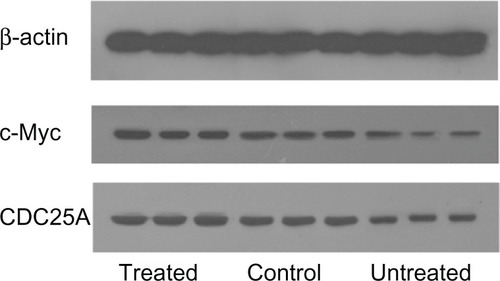
Figure 3 Western blot analysis of c-Myc and CDC25A expression in cancer cells.
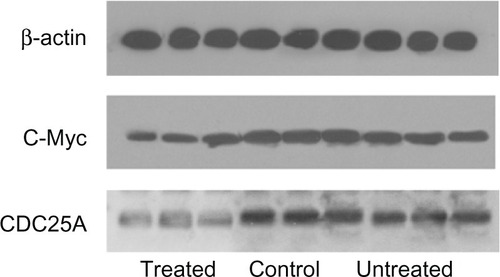
Table 6 Relative expression of c-Myc and CD25A in bone marrow and cancer cells (mean ± standard error)
p16INK4a and p15INK4b are the upstream suppression signals of CyclinD-CDK4/6. RT-qPCR analytical results showed no statistically significant differences between the relative expression of p16INK4a and p15INK4b among the three groups, both in the bone marrow and cancer cells (P < 0.05). Western blot analysis showed similar results (; and ).
Figure 4 Western blot analysis of p16INK4a and p15INK4b expression in bone marrow cells.
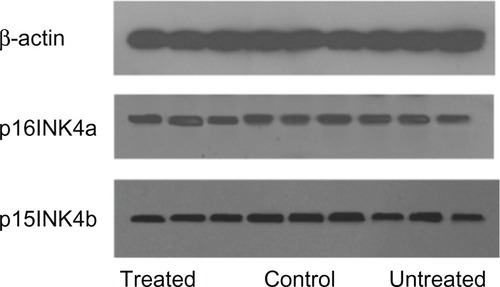
Figure 5 Western blot analysis of p16INK4a and p15INK4b expression in cancer cells.
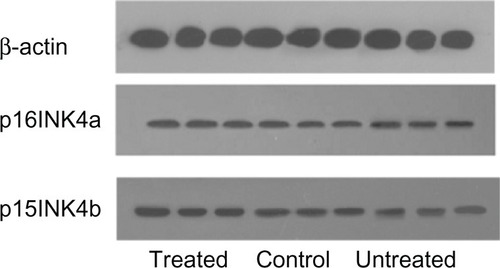
Table 7 Relative expression of p16INK4a and p15INK4b in bone marrow and cancer cells (mean ± standard error)
Rb, pRb, and E2F are the downstream signals activated by CyclinD-CDK4/6. The integration and separation usually relies on the activated status of CyclinD-CDK4/6. From the RT-qPCR analytical results, the expression of Rb, pRb, and E2F in bone marrow was significantly higher in the treatment group and control group compared to the untreated group (P < 0.05). Also, compared to the control group, the expression in the treatment group was significantly higher (P < 0.05). In contrast, the expression of Rb, pRb, and E2F in cancer cells among all the groups was similar, and there were no statistically significant differences (P > 0.05). Western blot analysis showed similar results ( and ; and ).
Figure 6 Western blot analysis of Rb, pRb, and E2F expression in bone marrow cells.
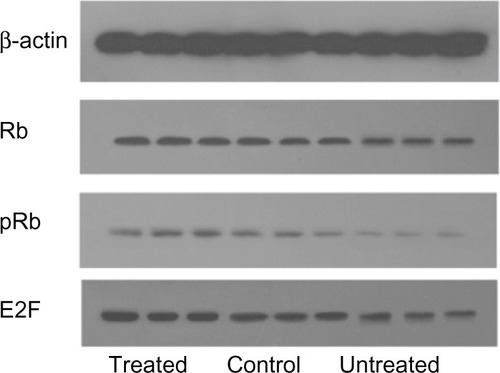
Figure 7 Western blot analysis of Rb, pRb, and E2F expression in cancer cells.
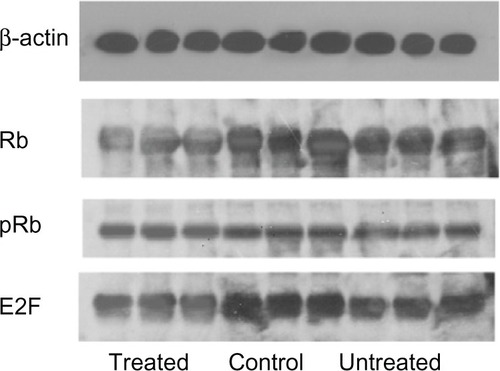
Table 8 Relative expression of Rb, pRb, and E2F in bone marrow cells (mean ± standard error)
Table 9 Relative expression of Rb, pRb, and E2F in tumor cells (mean ± standard error)
Discussion
The present study sheds light on the potential effects of the Shuanghuang Shengbai granule on the recovery of cancer patients from myelosuppression, by stimulating the bone marrow cell reproductive cycle, and by inhibiting the cancer cell reproductive cycle.
The current Lewis-bearing mice experimental approach established the dual control ability of the Shuanghuang Shengbai granule and its effect on CyclinD-CDK4/6’s upstream (c-Myc, CDC25A) and downstream signals (Rb, pRb, E2F). The experimental results revealed the increased expression of c-Myc, CDC25A, Rb, pRB, and E2F of the bone marrow in the Shuanghuang Shengbei granule-treated mice group, and decreased expression of these proteins in the cancer cells, explaining the effectiveness of the Shuanghuang Shengbei granule in controlling myelosuppression. The cancer growth and myelosuppression indicates an imbalance in the cell reproductive cycle. Cancer growth represents an over activated cell cycle, whereas myelosuppression represents an under activated cell cycle.
The mechanism of the cell reproductive cycle is controlled by CDK/cyclin, which is composed of the catalytic subunit, CDK and the regulatory subunit, cyclin. The gene coding for CDKs are highly conserved from yeasts to human beings. Mammalian CyclinD1/CDK4 complexes can also stimulate the growth of the Drosophila cell.Citation17
CDC25A, a dual-specificity protein phosphatase, is a member of the CDC25 family of phosphatases. It is required for the progression of phases from the G1 to the S phase of the cell cycle. CDC25A removes the inhibitory phosphorylation incyclin-dependent kinases, such as CDK2, CDK4, and CDK6, and positively regulates the activities of CDKs that lead to cell cycle progression. CDC25A also acts as an apoptosis regulator. The over expression of CDC25A promotes tumorigenesis, and is frequently observed in various types of cancer.Citation18
The proto-oncogene c-Myc encodes a transcription factor, which plays a critical role in the regulation of cellular proliferation, differentiation, and apoptosis. It has also been found to be deregulated in several forms of human and experimental tumors. Miliani et al showed that CDK4 is one of the critical downstream genes involved in c-Myc carcinogenesis. Their results showed that CDK4 inhibition in K5-Myc transgenic mice resulted in the complete inhibition of tumor development, suggesting that CDK4 is a critical mediator of tumor formation induced by deregulated Myc.Citation19 Mateyak et alCitation20 revealed that c-Myc regulates CyclinD/CDK4 and CDK6 activity, but affects cell cycle progression at multiple independent points. c-Myc-/- cells showed a 12-fold reduction in the activity of CyclinD1/CDK4 and CDK6 complexes during the G0 to S transition.
In 2001, three scientists won the Nobel Prize by discovering this core control mechanism of the cell reproductive cycle.Citation21 The integration of CDK4, CDK6, and CyclinD is necessary to initiate the G1 phase. The expression of CDK increases with the spilt of hematopoietic cells; however, the increase of CDK expression has a negative correlation with the growth of cancer cells.Citation22
Scientists have already observed the over expression of CyclinD in cancers such as breast cancer and esophageal cancer, with the expression having a negative correlation with prognosis.Citation23,Citation24 In a Lewis mice experiment, mice harboring defective CyclinD mutant cells were less prone to develop breast cancer when compared to normal mice. When the CyclinD defective mice mated with cancer-sensitive mice, their offspring still had a reduced chance of developing cancers.Citation25 In 2004, the Dana-Farber Cancer Institute (Boston, MA, USA) tested the mice lacking CyclinD1, D2, and D3 genes.Citation26 The test results showed the formation of normal embryo cells even after introducing oncogenes to embryo cells of mice without CyclinD.Citation19 In contrast, normal mice with the CyclinD gene were found to be more prone to developing cancer if their embryo cells were inserted with oncogenes.Citation26 In addition, with the decrease of cancer susceptibility, all mice embryos showed abnormal insufficiency of hematopoietic cells, causing them to be pale, anemic, and finally leading to death.Citation26
According to recent cell cycle research, over activated CDK/Cyclin causes the growth and development of cancer; chemotherapy drugs not only suppress the cancer cell’s reproductive cycle, but also suppress the split and growth of marrow hematopoietic cells, which finally cause insufficient expression of CDK/Cyclin in marrow cells and blood disorders.Citation27 Therefore, it is ideal that a drug used to treat myelosuppression is required to be able to decrease the expression of CDK/Cyclin in cancer cells and increase the expression of CDK/Cyclin in marrow cells.
CyclinD-CDK4/6, and its upstream and downstream signals, generate a complex network that work together to control the cell reproductive process. The phosphorylation of ribosomes release a lot of rested transcription factors, particularly E2F, and theses transcription factors can regulate the expression of multiple genes, which in turn translate into multiple types of proteins required for driving the cell reproductive cycle.Citation28 The expression of signals in the signal network whose core is CyclinD-CDK4/6 is the critical adjustment factor of the cell reproductive cycle,Citation29 and of the proliferation and differentiation of bone marrow hematopoietic cells.Citation27
Over the past 10 years, many researchers investigated the application of Chinese medicine to treat myelosuppression and many “strengthening–body–resistance -purpose” medicines have been developed.Citation30–Citation32 A meta-analysis showed the positive impact of Chinese medicine over Western medicine.Citation33 Chinese medicine not only increases leukocyte count, but it also helps patients improve their overall quality of life after chemotherapy. This supports Chinese medicine’s ability to stimulate bone marrow and induce hematopoiesis, improving quality of life. Chinese medicine, in addition to a strengthening body resistance purpose, also helps marrow stem cells/progenitor cells (or stromal cells) to grow and initiate blood generation.Citation34–Citation37 These medicines have the ability to enhance the expression of Cyclin in marrow cells.Citation37 Earlier research supports Chinese medicine in treating cancers, suppressing the growth of cancer cells,Citation37–Citation41 and in decreasing the expression of CDK/Cyclin in cancer cells.Citation42
All of these investigations signify the dual control nature of Chinese medicine on cell growth, stimulating different types of cells to grow in different ways, but at the same time. On a positive note, Chinese medicine could initiate the growth of marrow hematopoietic cells, while also suppressing the growth of cancer cells. The research results are fully aligned with the Chinese medicine theory, which applies an overall approach to treat disease while focusing on the recovery balance from Yin and Yang, as well as Qi.Citation43
According to traditional Chinese medicine, sickness is caused by the imbalance of Yin and Yang, Qi, and blood in the human body. The purpose of medication is to restore the balance by “reducing the surplus and supply of the weakness.”Citation43 Myelosuppression caused by chemotherapy usually has both “surplus” and a supply of “weakness”-excessive proliferation of cancer cells and insufficient proliferation of bone marrow cells. Bone marrow is defined as “marrow” in traditional Chinese medicine.
Based on the concept of the Yin-Yang balance, the new granule has been applied in clinical treatment and has been achieving positive responses in cancer. The function of the Shuanghuang Shengbai granule focuses on supplying kidney-Qi and generating marrow. Astragalus is sweet and warm, and it supports the supply of kidney-Qi, while Polygonatum is mild so as to replenish the kidney-essence. Furthermore, Ligustrum lucidum can nourish Yin and blood, while Drynaria can strengthen the bone and marrow.Citation44 These two drugs can facilitate Astragalus and Polygonatum to enhance their medical impact; therefore, these two drugs are called minister drugs.Citation44 The four drugs work mutually to realize the function of supplying kidney-Qi, replenishing kidney essence, and producing the marrow.
Traditionally, Chinese herbal medicines in oncology are based on the principles of strengthening body resistance, suppressing the proliferation of tumor cells, and promoting tumor cell apoptosis. Published literature suggests that the Shuanghuang Shengbai granule significantly increases the white blood cell count, BMNC, and colony forming unit-spleen of model mice. The Shuanghuang Shengbai granule helped the granulocyte and erythrocyte index to recover to a normal level, and it also helped enhance the proliferation of hematopoietic cells, while protecting the bone marrow hematopoietic micro environment from the harm of radiation. In addition, it appears to have an apparent leukogenic function.Citation45,Citation46 It has also been shown to offer obvious protecting and treating effects on chemotherapy-induced bone marrow suppression in patients with tumors.Citation47
The Shuanghuang Shengbaigranule could be potentially administered to cancer patients whose leukocyte count has been reduced due to chemotherapy, with a dosage of one bag (15 g) once or twice a day. Potential side effects may include diarrhea. The Shuanghuang Shengbai granule accelerates leukocyte production and improves the function of medullary hematopoiesis, reduces tumor size, suppresses the growth of tumors, and it has a dual control effect. Further research in cancer patients is necessary to establish the safety and efficacy of this immensely potent Chinese herb.
Acknowledgments
This work was supported by grants from the Research Fund for the Doctoral Program of Higher Education (Grant number 20093107110004), The Youth Talent Project of Pudong District (Grant number PWZq2009-1), National Natural Science Fund (Grant number 30973822), and the Research of Shanghai Health Bureau (Grant number 2009Y093).
Disclosure
The authors reported no conflicts of interest in this work.
References
- ZhongRBReview and outlook of small cell lung cancerChina Oncology200818147151 Chinese
- KirmaNLuthraRJonesJOver expression of the colony-stimulating factor (CSF-1) and/or its receptor c-fms in mammary glands of transgenic mice results in hyperplasia and tumor formationCancer Res200464124162417015205327
- GutschalkCMHerold-MendeCCFusenigNEMuellerMMGranulocyte colony-stimulating factor and granulocyte-macrophage colony-stimulating factor promote malignant growth of cells from head and neck squamous cell carcinomas in vivoCancer Res200666168026803616912178
- GongHShenPJinLXingCTangFTherapeutic effects of Lyciumbarbarum polysaccharide (LBP) on irradiation or chemotherapy-induced myelosuppressive miceCancer Biother Radiopharm200520215516215869449
- GuoPLiangQDHuJJWangJFWangSQThe effect of Siwu Tang on EPO and G-CSF gene expression in bone marrow of irradiated blood deficiency miceZhongguo Zhong Yao Za Zhi2005301511731176 Chinese16201694
- AlbertsBJohnsonALewisJRaffMRobertsKWalterPMolecular Biology of the Cell4th edNew YorkGarland Science, Taylor and Francis Group2002
- SongTDMedical Cell and Molecular BiologyBeijing2003 Chinese
- ZhaiZHWangXZDingXMZhai in higher education and the higher education pressCell BiologBeijing2000 Chinese
- SunPCTzaoCChenBHLiuC WYuCPJinJSSuberoylanilide hydroxamic acid induces apoptosis and sub-G1 arrest of 320 HSR colon cancer cellsJ Biomed Sci2010177620846458
- TakeuchiKChoiYLTogashiYKIF5B-ALK, a novel fusion oncokinase identified by an immunohistochemistry-based diagnostic system for ALK-positive lung cancerClin Cancer Res20091593143314919383809
- XuZYZhuYWZhouWDClinical observation on effect of ShuanghuangShengbaigranule and granulocyte-macrophage colony-stimulating factor on chemotherapy induced myelosuppression in tumor patientsTraditional Chinese Medicine200344919921 Chinese
- XuZYZhuYWZhouWDDouble Shengbai granules clinical studies of chemotherapy-induced bone marrow suppression and mouse bone marrow ultrastructure observationChinese Journal of Integrative Medicine20017277281 Chinese
- WangLFXuZYJinCJDual regulation of cell cycles by ShuanghuangShengbaigranule in Lewis-bearing mice with chemotherapy-induced myelosuppression and its mechanismZhong Xi Yi Jie He Xue Bao200975453457 Chinese19435560
- WangLFXuZYJinCJDouble Shengbai particle dual regulation of the cell cycle of tumor-bearing mice with Lewis lung cancerShanghai Traditional Medicine2009435660 Chinese
- LiuJWMethodology of Pharmacological Experiment. New Technology and MethodBeijingChemical Industry Press2003
- XuZYJUYFDouble Shengbai prescription preventing chemotherapy, bone marrow suppression experimental studyShanghai University of Traditional Medicine1999134345 Chinese
- DatarSAGalloniMde la CruzAMartiMEdgarBAFreiCMammalian cyclin D1/Cdk4 complexes induce cell growth in DrosophilaCell Cycle20065664765216582602
- ShenTHuangSThe role of CDC25A in the regulation of cell proliferation and apoptosisAnticancer Agents Med Chem201212663163922263797
- Miliani de MarvalPLMaciasERounbehlerRLack of cyclin-dependent kinase 4 inhibits c-Myc tum origenic activities in epithelial tissuesMol Cell Biol200424177538754715314163
- MateyakMKObayaAJSedivyJMc-Myc regulates cyclin D-Cdk4 and -Cdk6 activity but affects cell cycle progression at multiple independent pointsMol Cell Biol19991974672468310373516
- BalterMVogelGCycling toward StockholmScience2001294554250250311641478
- MiharaMShintaniSNakaharaYOver expression of CDK2 is a prognostic indicator of oral cancer progressionJpn J Cancer Res200192335236011267947
- ItamiAShimadaYWatanabeGImamuraMPrognostic value of p27(Kip1) and CyclinD1 expression in esophageal cancerOncology199957431131710575318
- UmekitaYOhiYSagaraYYoshidaHOver expression of cyclinD1 predicts for poor prognosis in estrogen receptor-negative breast cancer patientsInt J Cancer200298341541811920593
- SicinskiPDonaherJLParkerSBCyclin D1 provides a link between development and oncogenesis in the retina and breastCell19958246216307664341
- KozarKCiemerychMARebelVIMouse development and cell proliferation in the absence of D-cyclinsCell2004118447749115315760
- FurukawaYCell cycle control genes and hematopoietic cell differentiationLeuk Lymphoma200243222523111999551
- KrekWEwenMEShirodkarSAranyZKaelinWGJrLivingstonDMNegative regulation of the growth-promoting transcription factor E2F-1 by stably bound cyclin A-dependent protein kinaseCell19947811611728033208
- SantamariaDOrtegaSCyclins and CDKS in development and cancer: lessons from genetically modified miceFront Biosci2006111164118816146805
- DongLQHuRLZhouFCLiters of strong white tablets in the treatment of chemotherapy patients leukopenia attached: 58 cases reportedChengdu University of Traditonal Medicine2004275454 Chinese
- AiMHYuHXuYQKidney Pei-yuan soup treatment of chemotherapy-induced leukopeniaChinese Integrative Medicine Surgery200391819 Chinese
- LiPXChinese medicine treatment of cancer chemotherapy leukopeniaTianjin Traditional Chinese Medicine200421174176 Chinese
- LiXPChenZWangWXChinese medicine treatment of chemotherapy leukopenia Meta-analysisShanghai Journal of Traditional Chinese Medicine2003375255 Chinese
- TaoMFYangWDWangJHCiwujia injection of the protective effects of radiation injury in mice bone marrow micro environmentNanjing University of Traditional Chinese Medicine20042075177 Chinese
- WangLWangYExperimental study for the effect of TSPG on the expression of IL-3 in hematopoietic stromal cellsActa Anatomica Sinica20043514954
- ChengJFZhangYHeJRAstragalus polysaccharides on mice chemotherapy white blood cells and bone marrow nucleated cells reducedChinese Journal of Modern Applied Pharmacy20035378380 Chinese
- LuYZhongXYChenYChenQGChenZYLinDJEffect of ShenqiFuzheng injection of murine hematopoietic function chemo-therapyJournal of Tropical Medicine20055750752 Chinese
- HeDCHeHWuJPChinese herbal compound on the role of radiation damage in mouse bone marrow cell cycle gene and adhesion molecule expressionMedicine200411980981 Chinese
- LiZZangYHLiJThe Effect of the leukemia K562 cell cycle and apoptosis rate and membrane fluidityCancer Prevention and Treatment2004115557 Chinese
- ChaiXYWuWGLiuWSAnti-cancer effects about pcna of XIAO JI-decoction plus huacilansu on lung cancer cell in micesChina Journal of Chinese Materia Medica200425860 Chinese
- LiangYChenZXQiuHMDisinfect drinking leukemia K562 cell proliferation cycle and apoptosis in experimental studies, the raising of the positive impactTraditional Chinese Medicine20041014447 Chinese
- TangFAGongZJZhouHGene expression analysis of the implanted-tumor of nasopharyngeal carcinoma treating by YIQIJIEDU granule using human cancer cDNA arrayPractical Preventive Medicine200411637640
- ZhuMThe Medical Classic of the Yellow EmperorBeijingForeign Languages Press2011
- ShenNongBen Cao JingShen Nongs herbal ClassicWestern Han Dynasty Chinese
- ShenYHChenCXXuZYEffect of ShuanghuangShengbaigranule on radiotherapy or chemotherapy induced leukopenia in miceZhongguo Zhong Yao Za Zhi2005301612751279 Chinese16245909
- ShenYHChenCXXuZYExperimental research of ShuanghuangShengbaigranule on hematopoietic cells of leucopenia model miceZhongguo Zhong Yao Za Zhi2006319754759 Chinese17048686
- XuZYZhuYWZhouWDClinical and experimental study on effect of Shuanghuangshengbaigranule on myelosuppression induced by chemotherapy and ultrastructure observation of bone marrow in miceZhongguo Zhong Xi Yi Jie He Za Zhi2001215328331 Chinese12577413
